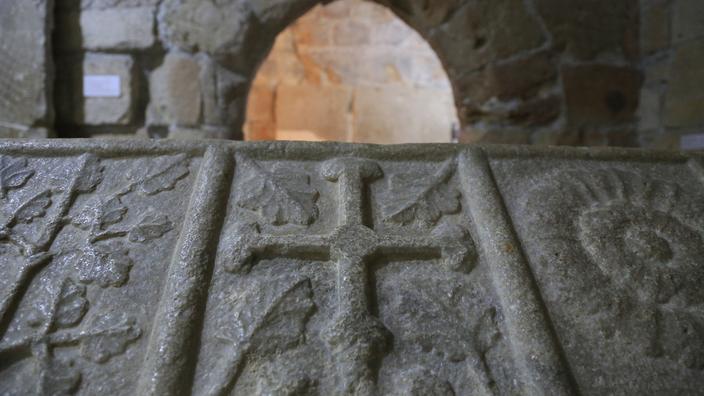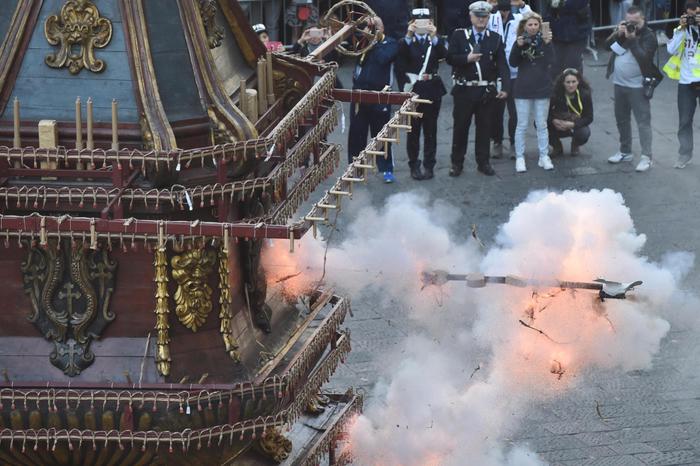Fantasies about the Templars are never ceasing to ferment the imagination but, in the depths of the island of Cyprus, a castle that belonged to the medieval brotherhood hides a very real heritage of the Crusaders, and still visible today. .
At the bottom of a narrow and steep stone staircase of the fort in the port city of Limassol, inside a vaulted hall and lined with tombstones of medieval knights, is the chapel where the King of England Richard I , says Cœur de Lion, would have married in 1192, on the road to the Third Crusade.
Read also: The true from the false of the Templars
“
The architecture and objects that are found here reflect the great history of Cyprus,
” says archaeologist Elena Stylianou, brandishing a long sword from the time of the Crusades, rusty and damaged but still sharp.
Given its strategic location, "
Cyprus was a place that many foreigners wanted to seize,
" she recalls.
Richard I celebrated his wedding night there by drinking sweet red wine before spending his honeymoon destroying the countryside, burning and looting until adding Cyprus to the list of his possessions, before selling it to the Templars .
A clay bulb that contained holy water, kept in the Medieval Museum of Cyprus.
Alex MITA / AFP
The Medieval Museum of Cyprus, housed in the fort, indicates that while the main walls of the castle date from the Ottoman period (16th century), they rest on much older foundations, and the vault is "
probably a chapel of the main fortifications of the Templars
' in Cyprus.
The Monastic Order of the Temple, founded in 1129 to protect European pilgrims traveling to Jerusalem, used Cyprus as their headquarters to carry out military campaigns authorized by the Pope in the Holy Land, just over 100 kilometers across the Mediterranean. .
Read also: When military orders reigned over Jerusalem
A Christian enclave at the gates of the Orient
For medieval Cypriot historian Nicholas Coureas, the Crusades are a key stage in the formation of Cypriot national identity: “
The most lasting consequence of Richard's conquest is that, although Cyprus has changed hands several times, it still has a European orientation, and most Cypriots identify more with Europe than with Asia or Africa
, he explains.
Thanks to its geographical position and its population, Cyprus borders on Europe but has close links with the Middle East
”.
The medieval Buffavento Castle, above the port of Kyrenia, in the self-proclaimed Turkish Republic of Northern Cyprus (TRNC), April 8, 2021. Birol BEBEK / AFP
Today, the island has been divided since 1974 when Turkey invaded and occupied the northern third in response to an Athens-sponsored coup aimed at reuniting the island with Greece. A United Nations buffer zone separates the Greek-speaking and predominantly Christian south from the Turkish Republic of Northern Cyprus (TRNC), recognized only by Ankara. Cyprus still has two British sovereign bases from which air operations in Libya or Syria have been launched over the past decade. This international friction in the heart of the island is reminiscent of its stormy medieval past. “
The Crusades are very relevant today, because there are a lot of parallels
,” observes Nicholas Coureas.
What also started at the time of the Crusades is the importance of Cyprus as a base for operations of Western forces operating in the Middle East and North Africa
”.
Another reference to the Crusades is the red wine Commandaria from Cyprus, named by the Templars, which is the oldest wine produced to be certified with a Controlled Designation of Origin, according to Guinness Records. Symbol of the persistence of this imaginary of the Middle Ages, crusaders appear on its label. If the Templars only possessed Cyprus for eight months, before selling it to the Frankish king of Jerusalem, Guy de Lusignan, for a time they kept castles on the island. Until being qualified as heretics and being burned at the stake in the 14th century, according to various works. Today, Cyprus remains dotted with castles and ruins left by the Crusaders, like that of Kolossi, once a base of the Knights Hospitaller order. Or, in the north, the castle of Saint-Hilarion,perched above Kyrenia Harbor, which seems to have inspired Walt Disney's Cinderella Castle. Infused with Greek, Turkish and Latin influences, the island of Cyprus remains an island at the crossroads of three worlds. And three stories.


/cloudfront-eu-central-1.images.arcpublishing.com/prisa/FY5V6P4GBFGVTJRMTBS4UOIEDA.jpg)



